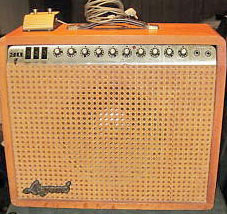Engineer: Billy Gibbons’ Eliminator Gear
(Part 2 of 3 on the ’80s BFG)
I don’t know about you, but from the vids in part 1, I hear the Rockman more so on Afterburner than Eliminator. His Eliminator tone doesn’t sound all that woody, but it also doesn’t have that hollow, distinct Rockman tone. So maybe we should listen to the engineer on that one.
Here’s what Eliminator engineer Terry Manning said Billy used on Eliminator:
“The amp used, almost exclusively, on Eliminator was a Legend. This was about a 50w hybrid unit, employing a tube/valve preamp and a transistor power amp. This is the amp which has a finished wood case, and a rattan-type cane grill. It has one 12” Celestion speaker.
“Legend were later bought by, or at least distributed by, Gibson, but they were independent when we started using them. I still have this amp – it is almost new. A couple of years ago I plugged one of the Eliminator guitars into it, just to see…there was the sound!
“We did use very briefly a small amp by Ross, but we didn’t like it much, and I think only a tiny part or two was kept from this, if any.
“The guitars were custom-built by Dean. Dean were out of Chicago, and were trying to break into the high-end…market. They were very nice, albeit different, instruments. Subsequently however, they got a contract with Sears to make guitars, so they opted for the big bucks, Korean-manufactured, low-end market instead. But the ones we used were very nicely made.
“There were two which we employed. One was somewhat like a cross between a Flying V and a Moderne shape, very long ‘ears,’ and the other was a sort of a warped, pointy Stratocaster-y shape. Both guitars had a single DiMarzio Super Distortion high-output pickup, and almost no controls. I don’t think there is even a tone control…what would you need one for?
“They have big, heavy, brass bridge/tail pieces bolted into the body. These guitars were very live, very resonant, and would verge on resonant feedback at all times. They were also very hard to keep in tune because of this. But they were always alive. Billy has the first one mentioned, and he gave me the latter, which I still have.”
Recording
Terry again:
“The guitar was recorded with basically only one setup: one amp (Legend), one speaker (12″), one guitar (Deans, the two were almost exactly the same), one mic (AKG 414B-ULS, I still have it) in one position (about 5” from the cone, placed at a slight angle off axis) and one mic pre (the SpectraSonics console). Ninety-eight percent of ALL guitar on this album, whether lead or rhythm, was done this way. Any variations were from the player himself, who, remember, did not even have a tone control. That’s how good Billy was back then.
“The rhythm guitars were done in a precursor-to-Protools style. Short phrases were played, and then double-tracked, onto one set of tracks, and then the chord change/next phrase was played on a second set of tracks. This allowed a seamless transition between changes. Dince the Deans were so close to feedback at all times (acoustically, through the fairly loud JBL monitors), we couldn’t even lift the fingers to change chords!
“Then I would trim the edges of each section by punching in and out to silence at the beginnings and ends of the phrases – somewhat analogous to “trimming the region” today. [Call me Beavis, but “trimming the region” is seriously a recording engineering term?]
“This method also ‘eliminated’ to a degree the loud harmonic squeaks between chord changes. The punch in/out points, if done exactly perfectly, made for a primitive cross fade of probably 10-20 ms, and ended up sounding very different as rhythm guitar, sort of like a big train rolling down a track, almost out of control: Without knowing how it was done, one wouldn’t really realise why it was different.
“For the leads, as always, there was a lot of punching done.”
I like this guitar tone…nasty.
More from Terry
> “The bass was mostly played either by Billy or by me, and was either a bass instrument or a Moog Source: The Source was a Mini Moog analogue synth with digitally controlled parameters…I still have this, too. Synth chords were played on a Memory Moog (polyphonic Mini).”
> “Billy sang great, different vocals, as usual, and the harmonies were done either by Jimmy Jamison or by me.”
> He also says in a different interview that, contrary to Billy’s story that a drum machine was used on Eliminator, “Well, I guess it can now be told, as long as you promise not to pass it on, but yes, I played the drums on ‘Legs,’ and in fact, almost the whole album. This song was recorded in my attic, except for Billy’s lead guitar and vocal, which came from a previous studio version which was unsatisfactory. (Oh, if I could tell the whole, real story! Maybe someday….)”
Really, 20 years later what’s the BFD? That must be some story!
Eliminator gets kind of a bad rap but has some cool tunes, like this one.
Category: Billy Gibbons, Celestion speakers, Dean guitars, Legend amps
















Love the tone on this album…….probably because I own a Legend!! Bought mine new back in '80 or '81(been a long time ago)…….played it in a rock band for awhile with a Les Paul……..ended up with a country rock group for a long time…sheved the Legend….used a Fender Chorus with a Strat……got back in R&R…dusted the Legend off…got another Les Paul……use a Pod just for a bit of reverb and compression…..it kicks ass yet!!